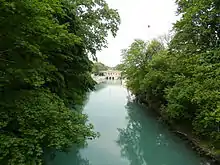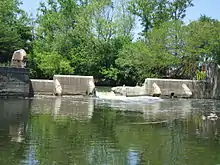North Shore Channel
The North Shore Channel is a drainage canal built between 1907 and 1910 to flush the sewage-filled North Branch of the Chicago River down the Chicago Sanitary and Ship Canal.[1] The sewage carrying duty has been largely taken over by the Chicago Deep Tunnel, but there are still occasional discharges due to heavy rains.[2]



Geography
The North Shore Channel flows from Lake Michigan, near the Bahá'í House of Worship in Wilmette, Illinois, to the North Branch of the Chicago River in Chicago.[3]
A sluice gate usually prevents the canal from back-draining out to Lake Michigan, although the gate must be opened occasionally to prevent downstream flooding.[1] The channel flows southwest, and then south, through or near Wilmette, Evanston, Skokie, and Lincolnwood, and into Chicago. The south end of the channel flows into the North Branch at approximately 5100 north and 3000 west in the Chicago street address numbering system. Chicago's only waterfall within the city limits, which looks like a concrete spillway, is in River Park, where the upper North Branch drops about 4 feet (1.2 m) through a dam into the confluence.[4] In March 2017 the Army Corps of Engineers announced a plan to remove the dam and replace it with a series of riffle pools, to allow fish to swim upstream.[5] In July 2018 the Corps began removing the dam.[6][7]
Surrounded by parks and steep, wooded banks, - and an 18 hole golf course Canal Shores Golf Course in parts of Wilmette and Evanston, Illinois - the canal provides a corridor for local wildlife.[1]
In 1999, the system of which the canal is a part was named a Civil Engineering Monument of the Millennium (as part of the Chicago wastewater system) by the American Society of Civil Engineers (ASCE).[8]
General Recreation
Since the water quality improvement, fishing has become possible in the canal.[9] Bass and crappie are abundant, especially at the confluence of the canal and the North Branch of the Chicago River, where the waterfall aerates the water.[10] Canoeing and kayaking are allowed, with several put-in points along the length.[11]
In recent years the canal has also become a popular rowing venue. Home to the Chicago Rowing Foundation, Loyola High School and New Trier High School. The canal is a great place for rowing due to its high banks that act as a shelter from the wind. The northern part of the river has hosted the Wisconsin And Syracuse men’s rowing teams for a duel both in 2016 and 2019.
In addition to water navigation, both walking and biking paths follow along nearly the entire length of the canal.[12] The Evanston-Wilmette Community Golf Course ("Canal Shores") plays along a stretch of the canal of about 1 mile (1.6 km), and two par-3 holes play across it.[13]
North Shore Channel Trail
The North Shore Channel Trail is a multi-use trail that starts at Lincoln Square near West Lawrence Avenue and North Francisco Avenue and stops in Evanston at Green Bay Road. Several improvements are expected to be completed in the fall of 2019, including the Lincoln Village Pedestrian Bicycle Bridge and the 312 RiverRun and its Riverview Bridge.[14][15] Other attractions along the trail include the Skokie Northshore Sculpture Park, which boasts over 60 large sculptures along the channel,[16] the Evanston Ecology Center, and the Ladd Arboretum.
References
- Hill, Libby (2000). The Chicago River, A Natural and Unnatural History. Chicago: Lake Claremont Press. pp. 139–151. ISBN 1-893121-02-X.
- "CSO - Operational and Maintenance Plan Summary". Village of Willmette. Retrieved 23 June 2014.
- "Where is the Chicago River?", Friends of the Chicago River. Retrieved August 18, 2014. "The Upper North Branch then continues to flow south through Niles into the city of Chicago, where it combines with the North Shore Channel at River Park and forms the North Branch of the Chicago River. The North Shore Channel starts in Wilmette flows through Skokie, Evanston and Lincolnwood to Chicago."
- "Chicago River Water Trails", Openland. Retrieved August 23, 2014.
- Wetli, Patty (March 31, 2017). "Chicago Is Losing Its Only Waterfall, and Nature Lovers Say Good Riddance". DNAinfo. Archived from the original on October 10, 2017. Retrieved October 9, 2017.
- Wetli, Patty (July 31, 2018). "The End of Chicago's Only 'Waterfall' Marks a New Beginning for Life on the River". Block Club Chicago. Retrieved August 1, 2018.
- Bookwalter, Genevieve (August 2, 2018). "With Removal of Century-Old Dam Underway, Nature Lovers Can Soon Kayak from Skokie to Chicago Riverwalk". Pioneer Press. Retrieved August 9, 2018.
- American Society of Civil Engineers. "Chicago Wastewater System". Retrieved 15 May 2011.
- "10 Places to Catch a Fish in Chicago". World Fishing Network.
- "River Park". Chicago Park District. Retrieved 23 June 2014.
- Author unknown (date unknown). North Shore Channel put-ins. Retrieved from http://www.paddleaway.com/put_ins?river_id_param=61.
- Raz, Katherine (2010). "Best Alternative to the Lakefront Path". Chicago Reader. Retrieved 2012-12-21.
- Evanston Wilmette Community Golf Course. "Scorecard". Archived from the original on 23 February 2014. Retrieved 12 February 2014.
- Wetli, Patty (2016-09-22). "A Bike-Friendly Bridge Over North Shore Channel Trail Finally Is Happening". Archived from the original on 2019-09-05.
- Hernandez, Alex V. (2019-07-01). "312 River Run's Massive Bridge For Pedestrians And Cyclists Won't Open Until Fall".
- "Park History". Skokie Northshore Sculpture Park. Retrieved 2019-09-05.